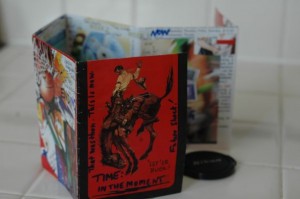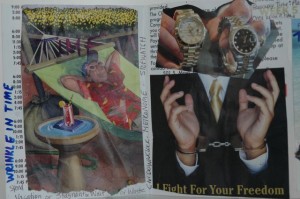I’ve been thinking a lot about the subject of “Time” lately, especially in terms of how we view it and use it and abuse it. Since watching the time and meeting deadlines and so forth seem to be fairly common concerns among so many creative people, I’ll be writing about time and our beliefs and attitudes about time occasionally over the next couple of weeks. (How’s that for a vague time frame!)
Here’s where I’m starting: a little handmade fold-out format booklet. This is actually a re-purposed folding tourist brochure from the huge annual rodeo in Pendleton, Oregon. I chose it as the basis for the exercise because I liked the picture of the horse.
I shortened the height of the original brochure by cutting it in half so it would be handier and a more appealing size, and used an ordinary glue stick to affix assorted pictures quickly clipped and ripped from magazines. Finally, I wrote on it with a ballpoint pen and a Sharpie permanent marker that happened to be in my desk drawer.
When time was up (!) and I eventually stopped to examine my work, some of the images I had chosen surprised me, especially when I saw how they had combined themselves seemingly on their own power. Images sure do exercise a different part of the brain and surface new combinations and juxtapositioning of ideas, and may remind us of what we might otherwise be unaware of, or ignore, or forget.
When we work quickly, we short-circuit the inner censor or the inner critic and skip past the rational or conscious decision making process. I had to laugh at some of my (un)intended choices, especially when I saw them in sequence from panel to panel. I continue to see more depth and richness each time I flip through the brochure which is fascinating: it’s all “accidental” because I did not do it “on purpose” — there was no time for finding just the right images, or fussing over which image would go where, or trimming the pictures with deliberate care, or even fiddling to glue them in nice and flat, let alone straight!
As an added bonus, as I mentioned when I wrote about that hand made journal workshop I attended with Lisa Sonora Beam recently, I love having something to hold in my hands. A paper journal or planner gives the project a tangible form and serves as a concrete container for my ideas.
Having this little booklet or journal or look-book helps me pull the thoughts and flashes of inspiration out of my head and put them down on the page where I can shuffle them, play with them, admire them, organize them in some fashion for safe-keeping, and yes, write on them and ponder over them some more.
Recording thoughts in a specially designated place like this makes them seem more real. I am finding this process quite helpful as both a record keeping tool and as a source of inspiration.
This hand made project journal took precisely two hours from start to finish: to decide on the form of the booklet, select the images, glue it all together, and scribble on it.
You bet I used a timer!
Setting the timer helped me relax because I knew there was a preset end time and I knew it fit into my schedule that day. I planned on two hours being adequate to devote to this aspect of my project. I found that the time limit helped me to stay focused and make decisions more easily, ie based on tools and materials literally within easy reach. I was committed to making the project book within the time allowed, so whatever happened with it, happened. It was enough time, but I knew there would be no extra time for perfection or over deliberation. I was forced to stay in the moment, focus, and stick with the process to get it done in the allowed time.
I found this to be a useful approach in that it limited scope creep, kept me from questioning my decisions, and helped me bypass by rational brain. The parameters kept it simple and quick, and I really enjoyed myself. I sank into it quickly and was absorbed or shall we say lost in the process, and as a result it brought out some interesting ideas, concepts and revealed some surprising feelings or beliefs I didn’t realize I had — so much rich material to follow up with later. Despite all that, it was relaxed enough that it did not become a total adrenaline rush followed by a compensatory crash.
Do you find that setting a time limit can be helpful that way?
Have you tried accessing your thoughts or feelings through this type of timed process using images?
If you’ve found this interesting or helpful, be sure to keep up to speed with future posts by subscribing to the rss feed (tiptop right) or get the posts by email (sign up in the right sidebar).


{ 4 comments }
I have done a few timed exercises using images with the VisualsSpeak (http://www.visualsspeak.com/) image sets, and they were all highly illuminating. I think you explained why when you wrote:
“Images sure do exercise a different part of the brain and surface new combinations and juxtapositioning of ideas, and may remind us of what we might otherwise be unaware of, or ignore, or forget.”
and
“When we work quickly, we short-circuit the inner censor or the inner critic and skip past the rational or conscious decision making process.”
Both of those were absolutely true for me, to the point where I was frankly astonished at some of the stuff that came through.
That was a more formal tool with facilitated exercises, but it looks like you’re doing a crafty, self-directed version of the same thing. I’m glad some of the juxtapositions made you laugh!
And I giggled myself at your use of the term “scope creep.” I’m used to hearing that in business consulting environments, not creative play!
I’ve had mixed results with timers. I’ve used them in a Pomodoro-Technique-type way (X minutes for work, Y minutes for rest), and sometimes that’s gone well — it seems to work best for me when I allow longer rest periods than work periods! But often the timer adds to my stress: I look at the timer and think I should be farther along than I am, and get frustrated and tense. With less-fraught projects, I might find the timer more relaxing, as you did. I’ll be thinking about what kinds of tasks might feel easier with a timer, for me.
Looking forward to reading your upcoming posts about time!
Oh yes, timers! Great idea.
I had similar experience as Michelle with visuals speak.
I like to set a timer to give part of myself assurance that I won’t “waste” too much time on whatever creative project I’m working on. It also helps me to just get started already, otherwise I’ll stare at the blank canvas forever.
But I also find that once I DO get started, the creative time feels so juicy that I just keep going. Which is a good thing for me.
Interesting post, Barbara. I’ve never used a timer…and even the thought makes me feel stressed. I think I’d have the same response Janet mentioned: always checking the time to see how much I have left!
What I have observed is how much I can get done in a short period when there’s a real, live, external deadline in place. For example, I’m giving a speech tonight – and I only found out about it yesterday morning. I mapped it out and created the power point deck last night. I’ll run through it a couple times today and be ready to go tonight.
It’s just like you say: there’s no time to question the decisions. If I had 2 weeks to prepare I’d spend most of that time second guessing myself, making changes and end up with something that *might* be marginally better. Or might not.